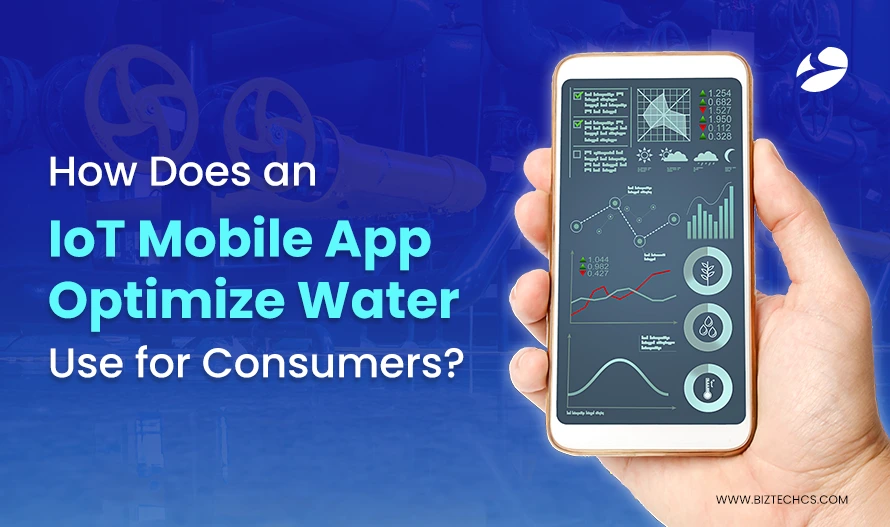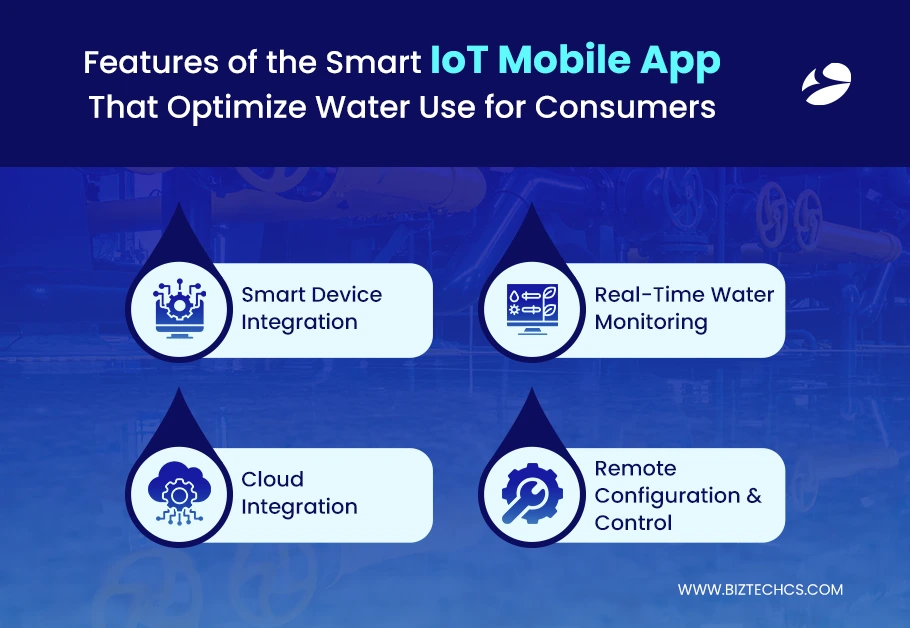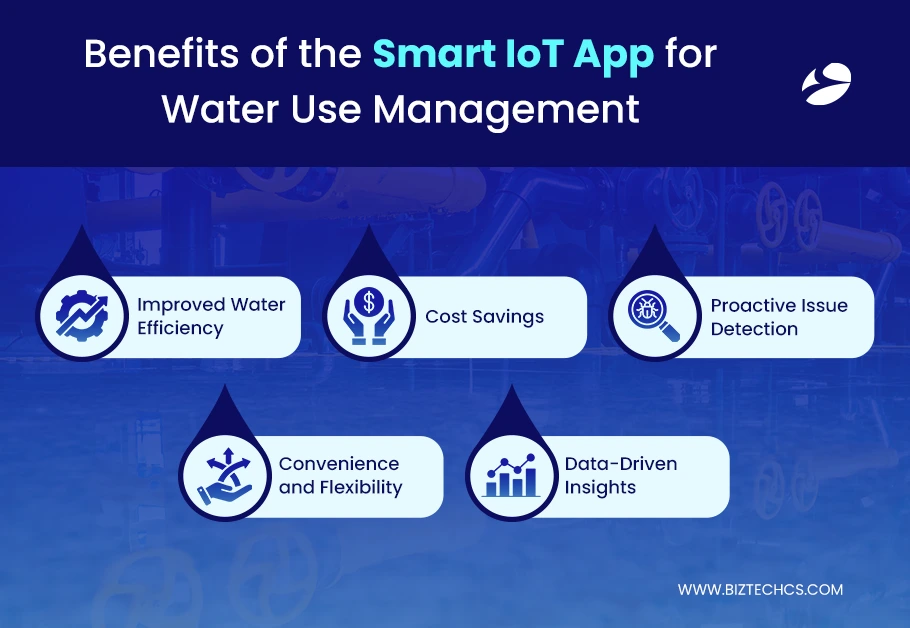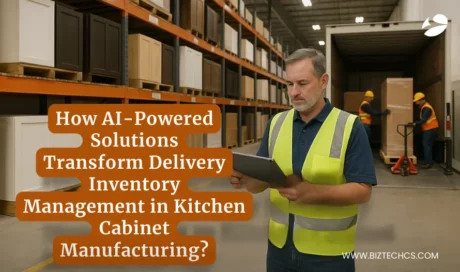1665
How Does an IoT Mobile App Optimize Water Use for Consumers?
30 Apr, 2025
10 min read
1665
30 Apr, 2025
10 min read
Table Of Content

Water conservation has become a pressing issue in the present age due to high demand and the scarcity of water resources. Traditional methods of water management do not utilize water to its fullest extent, leading to wastage and mismanagement.
This issue would be resolved on an entirely different level using a mobile app based on the Internet of Things, which can provide real-time monitoring of water and improved control of consumption behavior.
The IoT-enabled water management system would provide users with remote access to monitor and modify their water consumption on their mobile devices for better resource management.
With the growing interest in smart solutions, many organizations are turning to IoT mobile app development services to build intelligent systems that address these modern challenges. The app utilizes IoT cloud infrastructure for data collection and analysis, providing significant insights for both commercial and residential installations.
The technology will enable prevention, allowing it to identify a leak and notify the user before it becomes a critical issue.
In short, the IoT mobile app facilitates customers with tools that optimize their water utilization towards achieving sustainability objectives.
Traditional water monitoring methods often fail to provide real-time data due to their outdated approaches. Since such delays in data often miss identifying inefficiencies or issues, such as leaks or increased consumption, prompt action cannot be taken, leading to even more wastage.
Timely possession of real-time data can be a lifeline for water management, particularly in industries that rely on precision to minimize costs and optimize resource utilization.
Many conventional water management systems rely on manual checks of consumption, which carry a risk of human error and inconsistency. Additionally, inaccurate readings pose a significant challenge in accurately assessing the actual extent of water consumption due to the aged infrastructure.
This makes data unreliable and hampers decisions under water conservation strategies. Inconsistency in data further diminishes any remaining chances of effectively optimizing water use and may even skew accurate conclusions about water consumption behavior.
The operational and maintenance costs of traditional water monitoring systems are high due to different factors. Manual methods in setting up data collection, inspection, and hardware repair contribute to operational costs, which collectively form a significant pool.
Inefficiencies lead to excessive repairs and maintenance, resulting in downtime that incurs losses. Furthermore, high operational costs are a deterrent to investing in more advanced automated solutions that can improve efficiency.
In most cases, users of traditional water management systems have limited control over their water utilization, particularly regarding remote access. Such a lack of visibility prevents businesses and consumers from easily monitoring or making adjustments to their water consumption in real-time.
It also prevents the quick detection of issues that can be corrected to save water. The inadequacy of real water management results in inefficiencies and lost opportunities for conservation.
It becomes a slow, complex, and cumbersome endeavor to discover leaks and water wastage without conducting advanced monitoring on the dwelling or commercial site. Most traditional systems can scarcely detect leaks or wasteful consumption at an early stage, allowing such problems to persist for a long time.
Such delayed detection results in significant water loss over extended periods, leading to increased resource wastage and higher costs. Automated continuous monitoring in real-time is necessary to detect and immediately correct such occurrences before they worsen.
A smart IoT mobile app provides a comprehensive system to manage water consumption in real-time. It enables users to access their water consumption status from anywhere in the world, making critical data available at the touch of a button.
With this app, both enterprises and consumers can quickly adjust their water settings, hence optimizing their water use and minimizing wastage. This app also allows remote configuration and management of smart water devices. It collects and analyzes transactional data, providing users with necessary insights into water patterns to make informed decisions.
Users can also set alerts for suspicious water consumption or concerns, allowing them to manage their water usage proactively. This mobile app, therefore, promotes sustainable behavior and encourages immediate user action as needed to enhance water use control.

IoT mobile applications consolidate this device into a single system that is available through a smart water device. Such an integration can now enable the application to receive real-time information, constantly updated by sources like smart meters or sensors.
Users can easily manage their devices; these include setting the devices to balance their consumption with the quality of the output. The app makes it quite efficient and straightforward to manage multiple home devices, thereby ensuring that the water-saving potential is maximized.
It provides consumers with real-time access to water consumption data at their fingertips. The instantaneous notification would help the users to detect any abnormally high or low water consumption quickly.
With such prompts at hand, users will be better equipped to react when necessary. Up-to-date reporting would also be available on inefficiencies, leaks, and informed decision-making.
Thus, this ensures the application is always in real-time and reactive, allowing for the avoidance of all possible waste.
The app enables cloud-integrated data processing and storage for secure and efficient data management. Users will be able to view their water usage data at any time and from anywhere through the use of their cloud infrastructure.
As such, this will centralize the data, making it current and available on multiple devices. It also enables trend analysis for making future strategic decision-making and saving water for the long term, thus allowing long-term storage for cloud data.
All water management parameters can be remotely configured and controlled by users at any time and from anywhere using their mobile devices. It then provides the convenience of fine-tuning these parameters without being on-site.
Users can set timers, manage consumption limits, and activate water-saving modes, all remotely. Using remote controls, it defines the flexibility of usage and ensures at all times the optimal use of water.
Smart cities require innovative approaches to managing water. An IoT-based water management system helps detect leaks early. This reduces waste and lowers maintenance costs. Real-time water monitoring ensures supply meets demand without delay.
With IoT cloud infrastructure, data flows quickly from sensors to decision-makers. IoT water management is not just about saving water; it’s about using it right. When each drop counts, insight matters more than guesswork.

Users are up-to-date and in a position to track their water usage in real time, by pattern, and then adjust their consumption type accordingly. The most crucial part is faster revelation or instant notification, which has reduced water wastage and optimized resource use.
Thus, a more sustainable way of managing water, with proper advantages for both the environment and the overall cost of its users, will be effective.
The early detection of a leak or inefficiency is a protection for all users, with no need to expend extra amounts on unnecessary water.
The application continuously monitors water consumption and alerts users if an unusual event occurs. This preventive approach enables one to implement quick steps that significantly reduce the overall water bill.
Any irregular patterns of consumption will instantly trigger notifications from the app. The common reason for alerts involves a leak, a malfunction, or excessive usage of the water supply.
In all cases, the issue can be resolved at an early stage before expenses increase as a result of the problem.
Early detection thus saves time, money, and other resources by preventing more significant problems that would have resulted.
Remotely monitor and control water usage to manage the system anywhere. Flexibility implies freedom from constraints of place and time in monitoring water consumption.
It is thus made available to the user at their fingertips at all times, enabling efficient water management.
The app features a comprehensive suite of analytics that generates detailed reports, helping users understand their water consumption patterns. This enables them to relate the findings to better decision-making, optimize usage, and identify areas for improvement.
This data-driven approach will prove beneficial in effluent and sustainable water management over time.
Advanced Data Analytics will steer the bright future of water management. This will explain the different aspects of consumption patterns. In turn, end-users can expect a better understanding of their water consumption.
These insights would enhance commercial and consumer decision-making, enabling the maximization of materials usage and waste minimization, ultimately improving the overall water management picture.
It will utilize artificial intelligence and machines to predict future events related to the operation of a water system, employing predictive analytics. The study of historical data will help such a system predict events or even abnormal consumption patterns before they occur.
Thus, it will be possible for water management systems to take timely and proactive action regarding issues, thereby preventing problems and increasing operational efficiency.
Cloud technologies will enable easy management by any water system distributed across several points of access or devices.
With all data collected and made available in one central location, end-users will be able to monitor and control their water consumption in real-time anywhere.
Apart from having central data with easy updates for maintenance and efficiency, such an integration improves the reliability of the water management systems.
Sustainability will not only be the smarter future of water management but also the one that fast-tracks reduced waste and increased efficiencies in resource use.
With real-time monitoring and predictive analytics technologies, it will be possible to ensure the use of water only when and how much is needed, thereby conserving it.
While contributing to environmental preservation, these initiatives may promote sustainable practices in water usage across industries and communities.
Smart water management systems create new possibilities by moving the revolution beyond companies or their regions. The adoption of such technologies will ensure a smarter, greener, and more intelligent use of water throughout the global context.
Improving water management could have a significant impact on addressing global water scarcity in the near term and promoting long-term sustainability.
Ahead of all other IoT water-efficient technologies, the mobile app for water management offers very fast water monitoring and connectors for smart water devices. Immediate access to consumption data empowers users to conserve water and manage resources more effectively.
The IoT-based water management system allows a user to remotely operate and set water controls in a way that saves time and money.
Cloud integration also renders it possible to always keep the data fresh and accessible such that a user can view usage patterns and trends. Leaks and inefficiencies can be picked up at an early stage, thus saving significantly on costs and supporting sustainability.
While the IoT water management paradigm turns, further predictive technologies such as AI will consequently assist in nurturing conservation.
In other words, while it assists in immediate water optimization, the technology also ensures continuous improvement through the real-time control and monitoring of water, thereby enhancing the ultimate goal of sustainable conservation.

Artificial Intelligence (AI)
39
By Uttam Jain
19 Dec, 2025

Artificial Intelligence (AI)
117
By Uttam Jain
10 Dec, 2025

Artificial Intelligence (AI)
208
By Afzal Qureshi
09 Dec, 2025